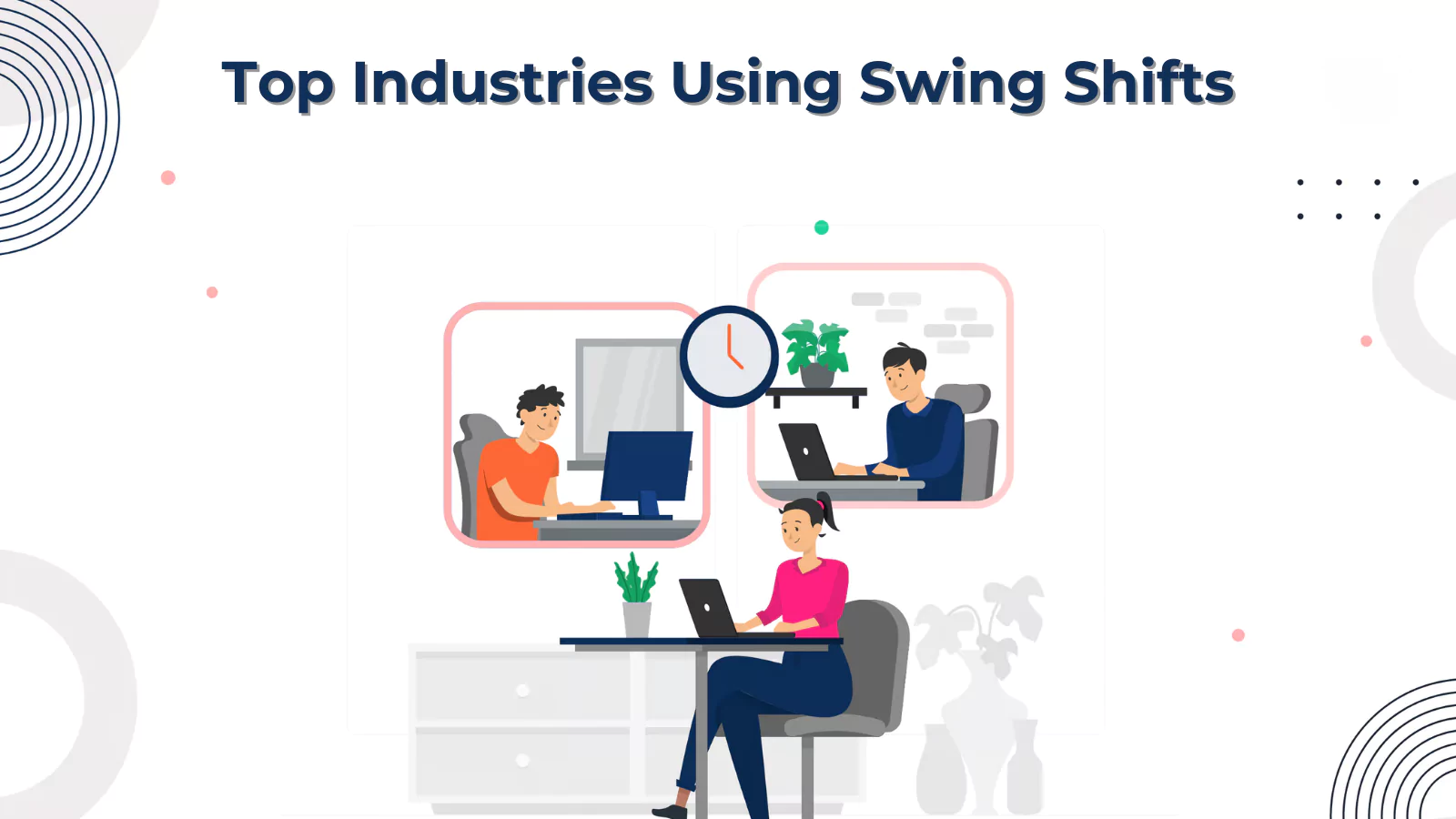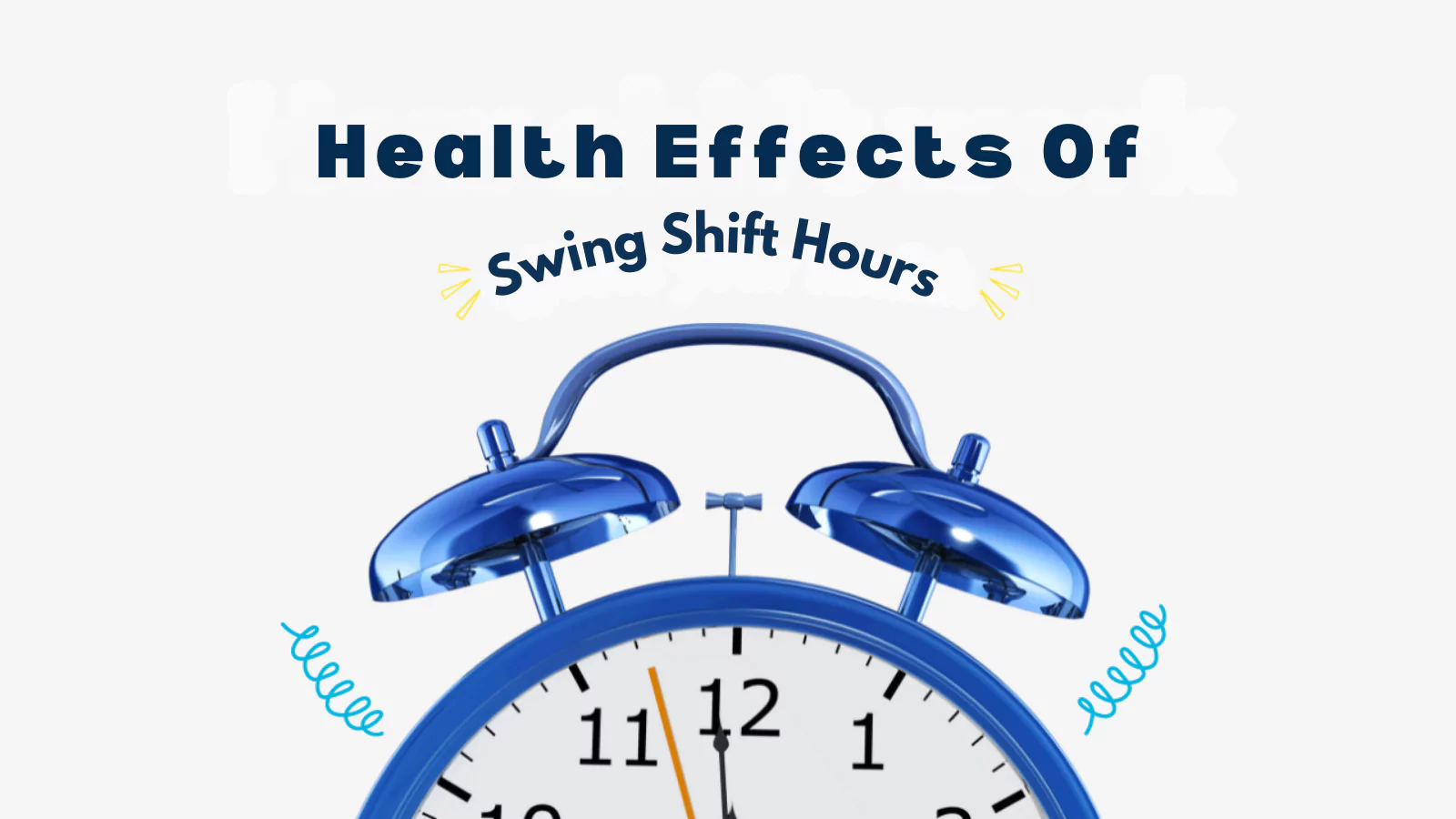Many businesses operate beyond the typical nine-to-five schedule, requiring employees to work different shifts. Swing shift hours fill the gap between regular daytime jobs and overnight shifts. These late-afternoon to midnight schedules are common in healthcare, retail, manufacturing, and customer service. While they keep businesses running smoothly, they also present unique challenges for workers. Managing productivity, maintaining a work-life balance, and ensuring proper rest can be difficult. Employers must create supportive policies, while employees need strategies to stay efficient and healthy. Understanding swing shift hours helps businesses and workers adapt to nontraditional schedules.
In a hurry? Listen to the blog instead!
What Are Swing Shift Hours?

Many businesses rely on these hours to meet late-day demands, ensuring that customer service, production, or healthcare continues seamlessly. In discussing the swing shift hours meaning, it is clear that this schedule fills a unique operational gap that supports extended service delivery.
Transitioning from a precise definition, we now explore why this schedule is a strategic choice for various industries.
Why Shift Hours Matter For Businesses?
For industries that operate around the clock, swing shift hours are essential. They ensure continuous service in sectors like healthcare, retail, manufacturing, and customer support. Businesses rely on these shifts to maintain efficiency during high-demand evening hours. Whether it’s a hospital ensuring patient care, a factory meeting production deadlines, or a retail store handling after-work shoppers, having staff available during these hours keeps operations smooth.
From a managerial standpoint, late shift hours present both advantages and challenges. They offer flexibility in workforce management, allowing businesses to optimize staffing levels. However, maintaining productivity, ensuring employee well-being, and complying with labor laws require careful planning. Many companies use a time management tool to schedule and monitor these shifts effectively. Advanced time tracking software also helps managers track attendance and performance, reducing errors and ensuring compliance.
Next, let’s compare swing shift hours with other work schedules.
Swing Shift vs. Rotating Shifts: Key Differences

1. Consistency vs. Variability
One of the main differences between these schedules is predictability.
- Swing shift hours follow a set timeframe, typically from late afternoon to midnight, allowing employees to develop a stable routine.
- Rotating shifts require workers to switch between different time slots, such as morning, evening, and overnight shifts, often on a weekly or biweekly basis. This inconsistency makes it harder to maintain a predictable routine.
For businesses, having employees on a fixed schedule ensures smoother operations, while constantly rotating shifts may cause frequent workforce adjustments.
2. Impact on Employee Well-Being
The impact of work schedules on health and personal life cannot be ignored.
- Fixed late-day shifts provide structure, making it easier for workers to regulate sleep patterns and maintain a work-life balance.
- Constantly changing hours can lead to circadian rhythm disruptions, resulting in sleep disorders, fatigue, and long-term health concerns.
When employees struggle with frequent schedule changes, their energy levels and mental health can suffer, leading to decreased performance and higher absenteeism.
3. Effect on Productivity
A steady schedule enables workers to plan and maintain efficiency.
- Employees with predictable shifts are more likely to stay engaged, focused, and productive.
- Those working fluctuating hours may have difficulty adjusting, affecting concentration and job performance.
For businesses, a stable workforce during late shift hours can lead to higher retention rates, as employees appreciate the reliability of a set schedule.
4. Suitability for Different Industries
- Swing shift hours are common in healthcare, retail, customer service, and manufacturing, where evening demand remains high.
- Rotating schedules are often required in emergency services, transportation, and global businesses that operate across different time zones.
Now that we’ve distinguished these schedules, let’s explore the industries that rely heavily on fixed evening shifts.
Top Industries Using Swing Shifts

Here are some key sectors that commonly implement this schedule:
1. Healthcare
Hospitals and clinics require continuous staffing to provide uninterrupted patient care. Medical professionals working late shifts assist in handling emergencies, ensuring smooth transitions between day and night teams.
2. Manufacturing
Factories and production plants schedule workers in the late afternoon and evening to keep production lines running efficiently. This approach helps meet deadlines, manage equipment maintenance, and balance workloads.
3. Retail
Retail stores often extend their hours to accommodate after-work shoppers. The evening staff assists with customer service, restocking, and preparing the store for the next business day.
4. Customer Service
Call centers and support teams must operate across multiple time zones, requiring employees to be available outside standard office hours. These shifts help businesses provide consistent customer assistance without delays.
5. Hospitality
Hotels, restaurants, and entertainment venues see peak activity later in the day. Staff working these hours enhance guest experiences, manage reservations, and ensure smooth service during busy periods.
A common question across these industries is how scheduling affects efficiency and employee well-being. The next section will explore the advantages and challenges of this work structure.
The Pros And Cons Of Swing Shift Hours
Balancing the benefits and challenges of working late-day shifts is essential for employees and employers. While these schedules provide flexibility and ensure business continuity, they also come with lifestyle adjustments. Here’s a closer look at the advantages and drawbacks.
Pros of Swing Shifts
More Flexibility for Daytime Activities
One of the biggest benefits is the ability to handle personal responsibilities during the morning hours. Employees can schedule appointments, run errands, or pursue hobbies without interfering with work.
Better Coverage During Peak Hours
Industries like retail, hospitality, and healthcare often experience increased activity in the evenings. Assigning staff during these hours ensures needs are met and operations run smoothly.
A More Predictable Routine
Unlike rotating shifts, which require constant adjustments, a set evening schedule allows employees to establish a stable routine. This consistency helps with work-life balance and reduces the stress of unpredictable hours.
Avoiding Early Mornings
For those who struggle with waking up early, evening shifts can be preferable. Employees can start their workday later without the pressure of early alarms and morning rush hours.
Potential for Higher Pay
Some companies offer shift differentials—extra pay for working outside the typical nine-to-five window. This financial incentive makes these shifts more attractive to workers seeking better earnings.
Cons of Swing Shifts
Disrupted Sleep Patterns
The body’s natural circadian rhythm is aligned with daylight, making it harder to adjust to late work hours. Irregular sleep schedules can lead to fatigue, reduced focus, and potential long-term health risks.
Challenges in Family Coordination
For employees with children or partners working traditional hours, managing family time can be difficult. Evening shifts may reduce opportunities for shared meals, school events, or quality time with loved ones.
Reduced Social Interaction
Many social activities, community events, and gatherings happen during the evening. Working late can limit participation in these events, making it harder to maintain friendships and social connections.
Increased Safety Concerns
Leaving work late at night may present safety challenges, particularly for employees commuting alone. Public transportation options may also be more limited during late hours.
Difficulty In Meal Planning
Late shifts can disrupt normal eating patterns, leading to reliance on fast food or unhealthy snacking. Employees need to be mindful of their nutrition and meal preparation to maintain good health.
Understanding these pros and cons allows businesses to implement strategies that support workers in managing their schedules effectively. Leveraging workforce management tools like EmpMonitor can help employers track attendance, monitor shift performance, and ensure compliance with labor regulations, making scheduling more efficient and employee-friendly.
EmpMonitor: The Time Tracking Software

Key Features of EmpMonitor for Swing Shift Management
- Automated Shift Scheduling – A reliable time management tool like EmpMonitor allows businesses to assign and adjust work hours effortlessly, reducing manual errors.
- Real-Time Attendance Tracking – With built-in time and attendance tracking software, employers can monitor check-ins, break times, and shift durations to ensure compliance and efficiency.
- Productivity Insights – Advanced reporting tools provide detailed analytics, helping businesses measure employee performance and identify areas for improvement.
- Compliance Monitoring – Ensures adherence to labor laws by maintaining accurate records of work hours, avoiding potential legal issues.
- Seamless Integration – The system works alongside existing HR tools, making implementation smooth and hassle-free.
By utilizing time tracking software like EmpMonitor, businesses can streamline shift planning, reduce scheduling conflicts, and create a well-organized work environment. Whether it is optimizing workforce distribution or improving operational efficiency, a robust shift management system can make a significant difference.
Best Practices For Employers
Implementing effective strategies to manage swing shift hours is vital for maintaining a balanced work environment. Here are several best practices that employers can adopt:
Strategic Scheduling
- Consistency: Wherever possible, maintain a consistent schedule for swing shifts. A predictable pattern helps employees adjust their routines, reducing fatigue and increasing efficiency.
- Rotation with Care: If rotations are necessary, ensure that changes are gradual to prevent disruptions in sleep and personal life.
Resource Allocation
- Adequate Staffing: Monitor peak hours closely and ensure that enough staff are available to handle the demand without overburdening individuals.
- Backup Plans: Prepare contingency plans in case of unexpected staff shortages or emergencies.
Supportive Environment
- Rest and Recovery Areas: Provide comfortable spaces where employees can take short breaks to rejuvenate during their shifts.
- Healthy Meal Options: Offering nutritious meal options can help sustain energy levels throughout the shift.
- Open Communication Channels: Encourage employees to share feedback regarding their schedules. This dialogue can lead to improvements in shift planning and overall satisfaction.
Leveraging Technology
Employers should consider integrating a time management tool that simplifies the tracking of working hours, breaks, and overtime. Such tools not only improve transparency but also contribute to a fair and balanced work environment.
Having established a solid foundation for employers, the next section provides actionable tips for employees working during these hours.
Health Effects Of Swing Shift Hours

Common Health Concerns
- Sleep Disorders: Irregular work schedules may cause difficulty in falling asleep or maintaining sleep, leading to chronic fatigue.
- Increased Stress Levels: The challenge of balancing work with personal life can result in elevated stress, which may, in turn, affect overall physical and mental well-being.
- Dietary Challenges: Limited access to healthy food options during off-peak hours might lead to poor dietary choices, further impacting health.
Mitigation Strategies
- Structured Breaks: Employers should ensure that employees working swing shifts get regular breaks to rest and recharge.
- Health Programs: Offering wellness programs that include stress management, nutritional advice, and exercise initiatives can help combat the negative effects.
- Professional Support: Encouraging consultations with healthcare professionals can also be beneficial in addressing ongoing health concerns.
Employers and employees must work together to create an environment where the challenges posed by swing shift hours are minimized, ensuring a healthier workforce.
Now that we have examined the health implications, it is crucial to understand the legal framework that supports these working arrangements.
Legal Guidelines For Swing Shifts
Navigating labor laws is essential when managing swing shift hours. Employers must remain compliant with national and state regulations to ensure that employees receive fair treatment and that the business avoids potential legal pitfalls.
Key Legal Considerations
- Overtime Regulations: Under the Fair Labor Standards Act (FLSA), employees working over 40 hours a week are eligible for overtime pay. However, specific rules may vary by state, and additional guidelines may apply to shifts scheduled during late hours.
- Mandatory Rest Periods: Some jurisdictions require that employees receive a minimum amount of rest between shifts. Understanding swing shift hours in the context of these legal requirements is critical for avoiding burnout and legal issues.
- Record-Keeping: Accurate documentation of working hours is essential. Implementing robust time and attendance tracking software can help in maintaining compliance with labor laws by ensuring precise records.
- Employee Rights: Employees should be aware of their rights regarding shift assignments, breaks, and overtime compensation. Employers must provide clear communication and adhere strictly to legal standards.
By incorporating these legal guidelines into daily operations, businesses can manage swing shift hours effectively while safeguarding employee rights and organizational integrity.
Read More
Conclusion
Swing shift hours play a crucial role in keeping businesses operational during high-demand evening periods. While they offer flexibility and ensure continuous service, they also present unique challenges for employers and employees. From managing productivity to maintaining work-life balance, adapting to this schedule requires strategic planning and supportive workplace policies.
For businesses, leveraging time tracking tools like EmpMonitor can streamline scheduling, enhance workforce management, and improve compliance with labor laws. Meanwhile, employees working these hours should prioritize healthy routines, proper rest, and effective time management to maintain well-being and efficiency.
By understanding the benefits, challenges, and best practices associated with swing shift hours, both businesses and workers can create a sustainable and productive work environment that supports long-term success.
FAQs
- What industries commonly use swing shift hours?
Swing shift hours are commonly found in industries that require extended or 24/7 operations, such as healthcare, customer service, security, transportation, retail, and manufacturing. These sectors rely on staggered shifts to maintain productivity and meet customer demands. - How do swing shifts impact family and social life?
Working swing shifts can make it challenging to align schedules with family and friends who follow a traditional 9-to-5 routine. However, proper time management and communication can help balance work responsibilities with personal commitments. - Are there any health risks associated with working swing shifts?
Yes, swing shifts can disrupt the body’s natural circadian rhythm, potentially leading to sleep disturbances, fatigue, and other health concerns. Prioritizing a consistent sleep schedule, a healthy diet, and regular exercise can help mitigate these risks. - What are some effective ways to transition into swing shift hours?
Gradual adjustments to sleep and meal schedules, avoiding caffeine close to bedtime, and using blackout curtains for daytime sleep can make transitioning to swing shift hours smoother. Maintaining a structured routine is key to adapting successfully. - What hours are swing shifts, and how do they differ from other shifts?
Swing shift hours typically fall between daytime and overnight shifts, often starting in the afternoon and ending late at night (e.g., 3 PM to 11 PM). They differ from day shifts (morning to evening) and night shifts (overnight to early morning), offering a middle-ground work schedule.










